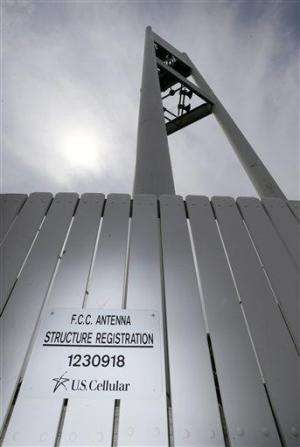Wireless companies put up more 'stealth' towers

One might be hidden in a cross on a church lawn. Others are disguised as a cactus in the desert, a silo in farm country or a palm tree reaching into a sunny sky.
Whatever the deception, the goal is the same: concealing the tall, slender cellphone towers that most Americans need but few want to see erected in their neighborhoods.
As telecommunications companies fill gaps in their networks, many have sought to camouflage the ungainly outdoor equipment that carries the nation's daily supply of calls, texts and data. It's another indication of how the industry is evolving to meet the demands of consumers who insist on ever-increasing amounts of wireless information but won't tolerate large antennas looming over their homes, parks and other beloved sites.
"Each community and each neighborhood can be different, so we really have to work on a case-by-case basis with each city and with each zoning authority," said Karen Smith, a spokeswoman for Verizon.
So-called stealth cellphone towers have been around for more than two decades and appear to be growing in popularity. They have been concealed in a wide variety of ways, including in a stop sign in New Orleans, a pine tree in Kinnelon, New Jersey, and a water tower in San Dimas, California.
Now an Iowa church wants to join the club by building a tower in the shape of a cross. It's a move that's irked some nearby residents who think the design will be too big and too out of place. It also shows how sensitive the issue can still be.
The First Presbyterian Church in Des Moines is working with Verizon to construct a tower that will be dressed up as an 11-story cross. The deal, which is being reviewed by a city zoning board, includes annual compensation to the church.
"Like a lot of churches, we have to keep each year finding ways to pay our bills," the Rev. Ken Stuber said. "It's an unusual church that doesn't have to worry about something like that."
Suzette Jensen said the tower's height and color wouldn't match the church's exterior, making it an instant eyesore. The pastor said that would not happen.
"We pay some pretty high property taxes. We feel very strongly that it's going to be a detriment to the value of our homes," she said, adding that neighbors are considering legal action.
Scenic America, a nonprofit that works to preserve scenery along the nation's roads, has generally opposed the building of more communication towers, but the group has been more amenable to disguised designs.
"We've been in favor of disguising them if you can and you can do it well," said spokesman Max Ashburn. But even some of the disguised towers are dead giveaways.
"You can tell right away that they're not what they pretend to be," Ashburn said. "Sometimes the attempt to cover them up actually makes it stand out more than if they just put up the tower."
When Verizon first contacted the church last year, the company proposed standard designs for the tower. The church ultimately pushed for the cross-shaped design, which mirrors a tower outside a church in the Minneapolis suburb of Eden Prairie.
STEALTH Concealment Solutions Inc., a South Carolina-based company that offers hidden antennas and towers, has created dozens of multi-tasking steeples and crosses over the years.
In 1992, a BP sign at a gas station in Atlanta earned the distinction of being the first stealth cellphone tower in the country, according to the company. Designs have expanded over the years and now include a quirky pole in Liberty, Michigan, that looks like a pencil.
Cindy Wishart, a STEALTH spokeswoman, said the company is constantly educating people about the industry and its possibilities.
"They always associate concealment as a tree," she said. "It's just so much more than that."
Specific data on the number of stealth towers is limited, but STEALTH said it works on up to 800 projects a year. The Wireless Association, an industry trade group also known at CTIA, said the presence of towers in general around the country has dramatically increased over the years in an effort to expand coverage.
At the end of 1997, the country had just over 50,000 cell towers. By the end of 2012, the most recent year for which information is available, that number had jumped to more than 300,000.
Stuber said he was surprised by the community backlash.
"It's ridiculous," he said. "Churches put up crosses all the time that are simply crosses. This will be a cross that's also helping us to pay our bills."
Jensen said the tower should be put in another location because space outside the church is too small. In Des Moines, a minimum 10-acre lot is needed for a communication tower. The church has just over three acres.
Smith, of Verizon, would not go into detail about the tower, although she did say the company chooses locations that fit within a geographic radius and meet engineering specifications.
People constantly need more data "to do all the different multimedia applications that are now part of their lives," Smith said, creating continual pressure to "add more capacity to our network to stay ahead of that demand."
© 2014 The Associated Press. All rights reserved.


















